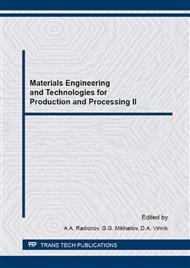p.550
p.558
p.564
p.568
p.573
p.578
p.584
p.593
p.598
Mathematical Modeling of Mechanized Technologies Soldering
Abstract:
The possibility of compliance with the required technological soldering conditions and ensuring their reproducibility for wave soldering, laser soldering, convection soldering have been researched. Comparing the experimental data to the results of mathematical modeling allowed selectng optimal modes of the wave, convection and laser soldering of electronic devices. The conclusion about the prospects of the analytical dependencies to improve mechanical soldering of electronic devices for any purpose. When heating by convection or wave solder, the temperature along the depth of the solder joints is less than when the contact or laser soldering. It was found that the temperature of the solder joints with infrared and laser soldering can be estimated based on the heat equation for a semi-infinite plate with a given heat flow on the surface. Warming up of the printing unit and, consequently, the solder joints when soldering, convection can be described by equations of the regular mode.
Info:
Periodical:
Pages:
573-577
Citation:
Online since:
September 2016
Authors:
Price:
Сopyright:
© 2016 Trans Tech Publications Ltd. All Rights Reserved
Share:
Citation:


